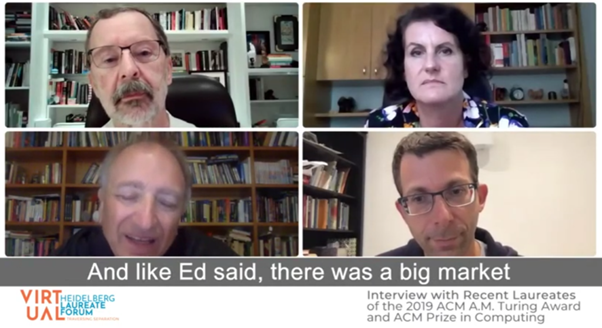Computer graphics researchers are finally getting the recognition they deserves — and it’s a good lesson for young researchers
Andrei Mihai
Pat Hanrahan and Edwin Catmull have often felt like underdogs in the computer science academic world. In a time when some of the greatest minds were creating AIs and cryptographic algorithms, the two spent their time helping Toy Story, Finding Nemo and Wall-E come to life.
What was their reaction upon receiving the Turing Award, the highest distinction in their field?
“Well, mainly, disbelief”, says Catmull, who sat down with Hanrahan, Gabriele Kotsis of the ACM, and David Silver, recipient of the ACM Prize in Computing.
“I was floored by the news to be honest. It was very surprising and exciting,” adds Hanrahan.
Catmull and Hanrahan are very familiar to the public — or rather, their work is. The two are known for their work at Pixar, which Catmull co-founded, hiring biophysics PhD Hanrahan as one of the employees in 1986.
Pixar, the animation studio behind many classic animation movies, was the place to be for computer graphics. The Catmull and Hanrahan spent much of their time working on creating realistic images and interactions. Hanrahan ended up building the famous RenderMan interface — a 3D application that renders real photographs into images — and Catmull invented techniques such as Z-buffering and texture mapping, which adds realism to graphics.
For Hanrahan, it wasn’t exactly what he set out to do initially, but it’s what he ended up falling in love with.
“I actually started out in Artificial Intelligence myself. I was actually a biophysicist, I was working on modeling nervous systems at the time and I got interested in realistic images because I thought in some sense, it would be creating an artificial world that was believable, that would require us to pass the Turing test.
It was sort of like an artificial intelligence quest for me.”

But it didn’t happen overnight. Behind every pretty image and animation, there’s a lot of ‘cool mathematics and technology’, and it took 20 years of intense work and optimism from Catmull to get it done.
Part of the reason why Catmull’s optimism was so pivotal in the field of computer graphics is that the field itself was not considered all that important.
“Within computer science, computer graphics was not considered to be important,” says Catmull. “It was isolated. When I graduated, I couldn’t get a job in academia because it wasn’t considered important.”
“I was working on things considered by others to be irrelevant.”
Well, the work of Catmull and Hanrahan not only made computer graphics relevant, but it also made it a driving force in computer science. The two have been awarded the 2019 Turing Prize, and their insights into programming graphics processing units (GPUs) have implications that spread far beyond computer graphics, impacting diverse areas including data center management and artificial intelligence. Incidentally, the two were also part of a research group that continuously pushed GPU manufacturers for extra performance — so you may want to thank them for that powerful computer of yours.
The talk also featured David Silver, recipient of the 2019 ACM Prize in Computing (read more about Silver’s individual talk on AI here).
“I have a long-term vision that we can achieve intelligence. It should be achievable in AI,” noted Silver, going on to explain reward can potentially lie at the basis of developing artificial intelligence.
At the end of the day, all three laureates thanked the entire community for their achievements, noting that a number of people in the same field are equally deserving of recognition. They all shared advice for younger researchers, with Hanrahan’s idea being particularly insightful.
“I would recommend not to listen to their advisor,” he laughed. Not on everything, mind you, just on finding the right path. “My advisor instilled in me the curiosity and desire to be a scientist and gave me a lot of freedom. But if you look at all of us, we all worked in an area that was not really hot and accepted at the time, it had to be reinvented. Parallel computing, neural nets, had to be reinvented. Advisors are good for you, but you have to find the right area for you.”
Relax like a laureate

After a long serious, talk, the laureates were also asked how they like to relax — and it was a joy to watch. Catmull sometimes looks at some quantum physics to relax, for instance. Silver enjoys long walks in nature, while Hanrahan has a truly enviable maker space. From sewing machines to assembling PCB boards, he enjoys tinkering with all sorts of things. They all love to stay active.
It’s one of the great things about computer science: it draws in people from different backgrounds, with different hobbies and different mindsets. Another great thing, the three agree, is that you can still make your mark in the field — you just need to find what works for you.
“We’re still at the forefront of computer science,” says Catmull, “and we’ve been at the forefront for 50 years”.
The post Computer graphics researchers are finally getting the recognition they deserves — and it’s a good lesson for young researchers originally appeared on the HLFF SciLogs blog.